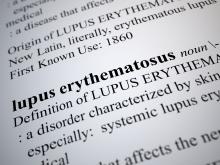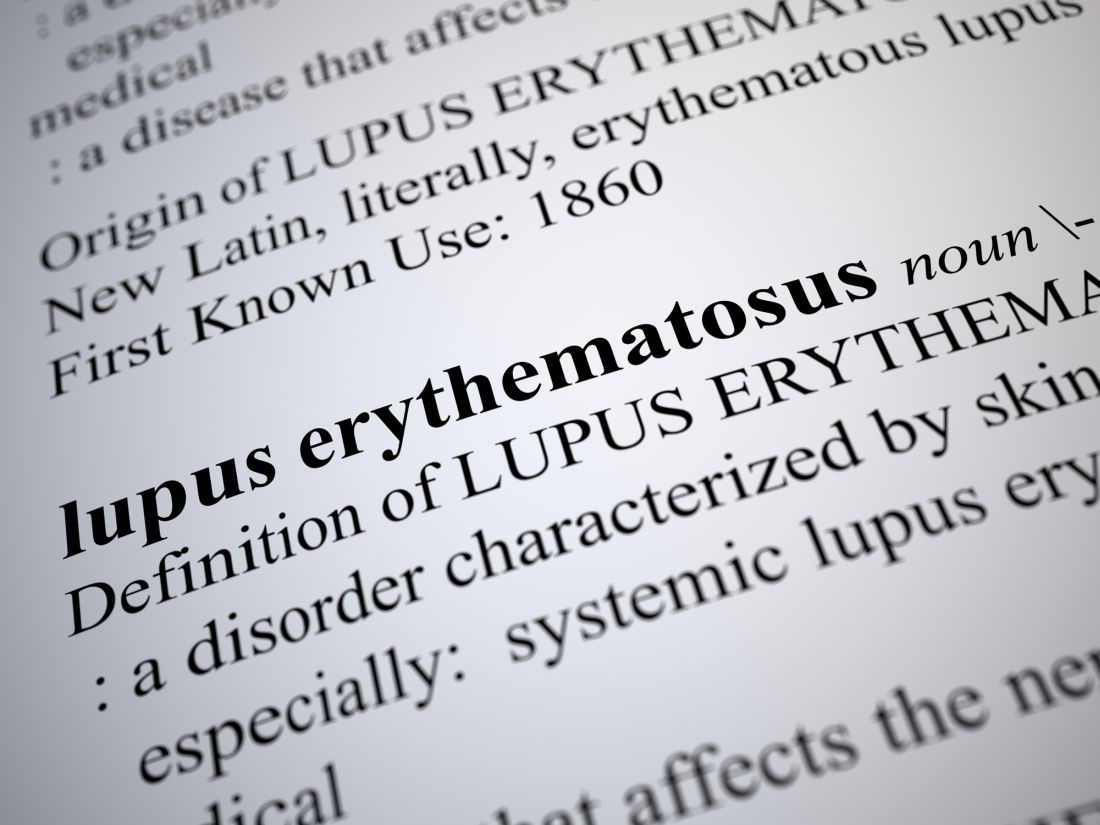User login
Patients with systemic lupus erythematosus (SLE) who were hypocomplementemic and anti–double-stranded DNA (anti-dsDNA) positive took weekly subcutaneous belimumab in addition to their standard therapy and saw reduced disease activity and fatigue at 1 year, compared with patients taking a placebo, according to results of a phase 3, double-blinded study. These results suggest the subcutaneous version of the monoclonal antibody therapy could be administered at home without patients visiting a hospital, the investigators wrote in Arthritis and Rheumatology.
“Intravenous administration of belimumab is an obstacle to treatment for many patients due to the need to go to the hospital for drug infusions. Thus, a higher number of patients could benefit from this treatment,” Andrea Doria, MD, from the University of Padua (Italy) stated in a press release.
Researchers set a primary endpoint of response rate according to SLE Responder Index (SRI4), no new British Isles Lupus Assessment Group organ domain A or B scores, and less than a 0.3 increase in Physician’s Global Assessment score at 52 weeks, compared with baseline scores; the secondary endpoints included corticosteroid use reduction between week 40 and week 52 of 25% or more to 7.5 mg/day or less, change in Functional Assessment of Chronic Illness Therapy–Fatigue score, and measurement of time to severe flare as measured by the SLE Flare Index.
At 52 weeks, 64.6% of patients in the belimumab group responded according to SRI4, compared with 47.2% of patients in the placebo group (P = .0014). The researchers attributed the high SRI4 response rate for the placebo group to “administration of SoC [standard SLE therapy]; increased chance of receiving active treatment due to the unbalanced randomization schedule, thereby resulting in a psychological benefit; and the high frequency of visits and patient satisfaction associated with clinical trials.”
Patients had lower flare rates according to the SLE Flare Index in the belimumab group (31.5%), compared with placebo (14.1%), and those in the former group had a 62% reduction in severe flares, compared with the placebo group (hazard ratio, 0.38; 95% confidence interval, 0.24-0.61; P less than .0001). More patients taking belimumab reduced their use of corticosteroids (20.7%) than did those taking the placebo (11.4%) (odds ratio, 2.08; 95% CI, 0.91-4.77; P = .0844). Of patients taking belimumab, 44.8% had a Functional Assessment of Chronic Illness Therapy–Fatigue score of 4 or higher at week 52, compared with 33.3% of patients taking placebo (OR, 1.82; 95% CI, 1.10-3.01; P = .0199).
Regarding adverse events, there were 88 (81.5%) adverse events in the placebo group, with 29 (26.9%) of those events considered to have occurred during treatment, compared with 79 of 194 (31.9%) adverse events attributed to treatment in the belimumab group. The researchers reported 25 patients in the placebo group (23.1%) and 33 patients in the belimumab group (13.3%) had serious adverse events. Postinjection systemic reactions occurred in 21 patients (8.5%) and 13 patients (12.0%) in the belimumab and placebo groups, respectively.
“Some aspects of this study were identified as potential limitations,” Dr. Doria and his colleagues wrote. “Within the hypocomplementemic and anti-dsDNA positive subset population, only 65.7% of patients received steroids greater than 7.5 mg/day at baseline; thus (as in the overall population), this endpoint was not powered for statistical significance. In addition, this study excluded patients with SELENA-SLEDAI less than 8, active nephritis, or active CNS disease at screening.”
The study was funded, conducted, and designed by GlaxoSmithKline. Five authors have shares in and are employees of GSK; another was an employee of GSK at the time of the study. Seven authors declared consulting fees, grants and other remuneration from pharmaceutical companies, including GSK.
SOURCE: Doria A et al. Arthritis Rheumatol. 2018 Apr 18. doi: 10.1002/art.40511.
Patients with systemic lupus erythematosus (SLE) who were hypocomplementemic and anti–double-stranded DNA (anti-dsDNA) positive took weekly subcutaneous belimumab in addition to their standard therapy and saw reduced disease activity and fatigue at 1 year, compared with patients taking a placebo, according to results of a phase 3, double-blinded study. These results suggest the subcutaneous version of the monoclonal antibody therapy could be administered at home without patients visiting a hospital, the investigators wrote in Arthritis and Rheumatology.
“Intravenous administration of belimumab is an obstacle to treatment for many patients due to the need to go to the hospital for drug infusions. Thus, a higher number of patients could benefit from this treatment,” Andrea Doria, MD, from the University of Padua (Italy) stated in a press release.
Researchers set a primary endpoint of response rate according to SLE Responder Index (SRI4), no new British Isles Lupus Assessment Group organ domain A or B scores, and less than a 0.3 increase in Physician’s Global Assessment score at 52 weeks, compared with baseline scores; the secondary endpoints included corticosteroid use reduction between week 40 and week 52 of 25% or more to 7.5 mg/day or less, change in Functional Assessment of Chronic Illness Therapy–Fatigue score, and measurement of time to severe flare as measured by the SLE Flare Index.
At 52 weeks, 64.6% of patients in the belimumab group responded according to SRI4, compared with 47.2% of patients in the placebo group (P = .0014). The researchers attributed the high SRI4 response rate for the placebo group to “administration of SoC [standard SLE therapy]; increased chance of receiving active treatment due to the unbalanced randomization schedule, thereby resulting in a psychological benefit; and the high frequency of visits and patient satisfaction associated with clinical trials.”
Patients had lower flare rates according to the SLE Flare Index in the belimumab group (31.5%), compared with placebo (14.1%), and those in the former group had a 62% reduction in severe flares, compared with the placebo group (hazard ratio, 0.38; 95% confidence interval, 0.24-0.61; P less than .0001). More patients taking belimumab reduced their use of corticosteroids (20.7%) than did those taking the placebo (11.4%) (odds ratio, 2.08; 95% CI, 0.91-4.77; P = .0844). Of patients taking belimumab, 44.8% had a Functional Assessment of Chronic Illness Therapy–Fatigue score of 4 or higher at week 52, compared with 33.3% of patients taking placebo (OR, 1.82; 95% CI, 1.10-3.01; P = .0199).
Regarding adverse events, there were 88 (81.5%) adverse events in the placebo group, with 29 (26.9%) of those events considered to have occurred during treatment, compared with 79 of 194 (31.9%) adverse events attributed to treatment in the belimumab group. The researchers reported 25 patients in the placebo group (23.1%) and 33 patients in the belimumab group (13.3%) had serious adverse events. Postinjection systemic reactions occurred in 21 patients (8.5%) and 13 patients (12.0%) in the belimumab and placebo groups, respectively.
“Some aspects of this study were identified as potential limitations,” Dr. Doria and his colleagues wrote. “Within the hypocomplementemic and anti-dsDNA positive subset population, only 65.7% of patients received steroids greater than 7.5 mg/day at baseline; thus (as in the overall population), this endpoint was not powered for statistical significance. In addition, this study excluded patients with SELENA-SLEDAI less than 8, active nephritis, or active CNS disease at screening.”
The study was funded, conducted, and designed by GlaxoSmithKline. Five authors have shares in and are employees of GSK; another was an employee of GSK at the time of the study. Seven authors declared consulting fees, grants and other remuneration from pharmaceutical companies, including GSK.
SOURCE: Doria A et al. Arthritis Rheumatol. 2018 Apr 18. doi: 10.1002/art.40511.
Patients with systemic lupus erythematosus (SLE) who were hypocomplementemic and anti–double-stranded DNA (anti-dsDNA) positive took weekly subcutaneous belimumab in addition to their standard therapy and saw reduced disease activity and fatigue at 1 year, compared with patients taking a placebo, according to results of a phase 3, double-blinded study. These results suggest the subcutaneous version of the monoclonal antibody therapy could be administered at home without patients visiting a hospital, the investigators wrote in Arthritis and Rheumatology.
“Intravenous administration of belimumab is an obstacle to treatment for many patients due to the need to go to the hospital for drug infusions. Thus, a higher number of patients could benefit from this treatment,” Andrea Doria, MD, from the University of Padua (Italy) stated in a press release.
Researchers set a primary endpoint of response rate according to SLE Responder Index (SRI4), no new British Isles Lupus Assessment Group organ domain A or B scores, and less than a 0.3 increase in Physician’s Global Assessment score at 52 weeks, compared with baseline scores; the secondary endpoints included corticosteroid use reduction between week 40 and week 52 of 25% or more to 7.5 mg/day or less, change in Functional Assessment of Chronic Illness Therapy–Fatigue score, and measurement of time to severe flare as measured by the SLE Flare Index.
At 52 weeks, 64.6% of patients in the belimumab group responded according to SRI4, compared with 47.2% of patients in the placebo group (P = .0014). The researchers attributed the high SRI4 response rate for the placebo group to “administration of SoC [standard SLE therapy]; increased chance of receiving active treatment due to the unbalanced randomization schedule, thereby resulting in a psychological benefit; and the high frequency of visits and patient satisfaction associated with clinical trials.”
Patients had lower flare rates according to the SLE Flare Index in the belimumab group (31.5%), compared with placebo (14.1%), and those in the former group had a 62% reduction in severe flares, compared with the placebo group (hazard ratio, 0.38; 95% confidence interval, 0.24-0.61; P less than .0001). More patients taking belimumab reduced their use of corticosteroids (20.7%) than did those taking the placebo (11.4%) (odds ratio, 2.08; 95% CI, 0.91-4.77; P = .0844). Of patients taking belimumab, 44.8% had a Functional Assessment of Chronic Illness Therapy–Fatigue score of 4 or higher at week 52, compared with 33.3% of patients taking placebo (OR, 1.82; 95% CI, 1.10-3.01; P = .0199).
Regarding adverse events, there were 88 (81.5%) adverse events in the placebo group, with 29 (26.9%) of those events considered to have occurred during treatment, compared with 79 of 194 (31.9%) adverse events attributed to treatment in the belimumab group. The researchers reported 25 patients in the placebo group (23.1%) and 33 patients in the belimumab group (13.3%) had serious adverse events. Postinjection systemic reactions occurred in 21 patients (8.5%) and 13 patients (12.0%) in the belimumab and placebo groups, respectively.
“Some aspects of this study were identified as potential limitations,” Dr. Doria and his colleagues wrote. “Within the hypocomplementemic and anti-dsDNA positive subset population, only 65.7% of patients received steroids greater than 7.5 mg/day at baseline; thus (as in the overall population), this endpoint was not powered for statistical significance. In addition, this study excluded patients with SELENA-SLEDAI less than 8, active nephritis, or active CNS disease at screening.”
The study was funded, conducted, and designed by GlaxoSmithKline. Five authors have shares in and are employees of GSK; another was an employee of GSK at the time of the study. Seven authors declared consulting fees, grants and other remuneration from pharmaceutical companies, including GSK.
SOURCE: Doria A et al. Arthritis Rheumatol. 2018 Apr 18. doi: 10.1002/art.40511.
FROM ARTHRITIS & RHEUMATOLOGY
Key clinical point: Subcutaneous belimumab reduced disease activity and fatigue in SLE patients, compared with placebo.
Major finding: In the belimumab group, 64.6% of patients were SLE Responder Index responders, 31.5% showed lower severe SLE Flare Index scores, and 20.7% of patients reduced use of corticosteroids to 7.5 mg/day or less between week 40 and week 52.
Study details: A phase 3, double-blinded, placebo-controlled study of 356 patients over 52 weeks.
Disclosures: The study was funded, conducted, and designed by GlaxoSmithKline. Five authors have shares in and are employees of GSK; Another was an employee of GSK at the time of the study. Seven authors declared consulting fees, grants and other remuneration from pharmaceutical companies, including GSK.
Source: Doria A et al. Arthritis Rheumatol. 2018 April 18. doi: 10.1002/art.40511.

